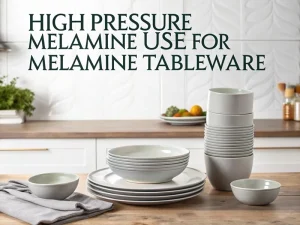
High Pressure Nelamine Use For Melamine Tableware Advantage
Tech Blog High Pressure melamine Use For Melamine Tableware Melamine tableware has become a staple for households, restaurants, and catering services worldwide due to its

Melamine powder is everywhere. It exists in our durable picnic plates, children’s brightly colored tableware, smooth cabinet surfaces, and even some industrial coatings that contain melamine. Given its widespread existence, a key question often arises: Is melamine a carcinogen?
In short, the answer is: no, according to major international health and safety organizations, melamine itself is not classified as a human carcinogen when used as expected in finished products such as tableware.
However, the overall situation is far more complex than that.
This is the most crucial difference. Melamine products (plates, bowls, and tableware) are not pure melamine, but are made from melamine formaldehyde resin.
Melamine (C₃H₆N₆): a stable nitrogen-rich organic compound. It has low toxicity and is not considered a carcinogen.
Formaldehyde (CH₂O): a highly active chemical substance used to connect melamine molecules. Formaldehyde is a known human carcinogen (Group 1 carcinogen of the International Agency for Research on Cancer), and long-term inhalation of large amounts of formaldehyde can lead to death.
During the production process, a chemical reaction called polymerization combines formaldehyde and melamine molecules to form a very stable, hard, and inert plastic. In high-quality melamine products with good curing, formaldehyde is no longer “free” but is bound to the resin structure in the form of chemical bonds. Therefore, the risk does not come from the finished product itself, but from the potential release (migration) of its trace residual components.
When determining whether a substance is carcinogenic, we refer to authoritative institutions specializing in toxicology and cancer research. Their classification is based on extensive scientific evidence.
International Agency for Research on Cancer (IARC): IARC is affiliated with the World Health Organization (WHO) and is the gold standard for global classification of carcinogens. IARC classifies melamine as a Group 3 carcinogen: ‘Its carcinogenicity to humans cannot be determined’. This means that there is currently insufficient evidence to prove that melamine can cause cancer in humans.
The US Food and Drug Administration (FDA) has conducted a safety and risk assessment of melamine. The conclusion is that melamine tableware and food contact products are safe within their intended use range. The FDA has established a daily tolerable intake (TDI) for melamine, and studies have shown that the amount of melamine that may migrate from tableware into food is more than 250 times below this safe level.
The European Food Safety Authority (EFSA): Similar to the US Food and Drug Administration (FDA), EFSA has established a daily allowable intake (TDI) for melamine and considers its use in food-contact materials to be safe under regulated conditions.
In short, the global scientific community’s consensus is that this material, in its solid state, does not pose a carcinogenic risk.
Most toxicological studies on melamine focus on its effects on the kidneys, as high doses may lead to kidney stones or kidney failure (the most famous case being the 2008 pet food and infant formula contamination incident, when melamine was illegally added to falsify protein quality test results).
Research related to cancer: A few animal studies have tested the effects of long-term high-dose melamine. For example, a 2014 study in rats found that, even though the dose was much higher than the typical human exposure level, there was no clear evidence that cancer incidence increased.
Combined action with cyanuric acid: Some studies suggest that combining melamine with cyanuric acid (a related compound) may form crystals in the kidneys, but this is associated with acute toxicity rather than cancer.
For most people, exposure to melamine is low, mainly through:
Food contact materials: Melamine tableware, cups, or food containers may release small amounts of melamine into hot, acidic, or salty foods such as tomato sauce and coffee. The US FDA estimates that the typical daily intake resulting from this is below 0.0005 milligrams per kilogram of body weight, far below the safety threshold.
Inhalation of dust: Melamine resin used in furniture, flooring, or electronic products may shed small particles, but exposure levels in indoor environments are usually low.
Industrial environment: Workers involved in melamine production or resin manufacturing may face higher levels of exposure, but such situations are subject to safety limit regulations (for example, the US Occupational Safety and Health Administration sets the allowable exposure limit for melamine dust at 6 milligrams per cubic meter).
The only possible risk from melamine tableware comes from chemical migration—the process by which trace amounts of chemicals seep into food from plastics. This aspect is strictly regulated, and under normal circumstances, its content can be ignored.
However, in the following two situations, the number of immigrants may significantly increase:
High temperature (especially microwave heating): This is the top priority for the safety of melamine tableware. Do not heat melamine tableware in the microwave. The microwave’s high temperature can damage the resin, leading to excessive levels of melamine and formaldehyde seeping into the food. Although occasional misuse is unlikely to cause harm, repeated misuse is still not recommended.
High-acidity foods exposed to heat: Prolonged exposure to high-acidity foods (such as lemon juice, tomato sauce, or orange juice), especially at high temperatures, can slightly accelerate the migration rate of acidic substances. Eating these foods is not a problem, but storing them in melamine containers for a long time or several days is not ideal.
Although melamine is not classified as a carcinogen, exposure can still be reduced through the following cautious measures:
Avoid high-temperature use: Do not put melamine tableware in the microwave or use it to hold boiling liquids, as high temperatures can accelerate the release of melamine.
View certification label: Select food-grade melamine products labeled as compliant with FDA, EU, or national safety standards (such as LFGB in Germany).
Reduce contact with acidic foods: For acidic foods such as citrus and vinegar, use alternative materials (glass or stainless steel), as acidic environments can accelerate the dissolution of melamine.
Ventilation in indoor spaces: Improve air circulation and reduce exposure to formaldehyde and dust from melamine-based furniture or laminated boards.
According to existing scientific evidence and regulatory classification, melamine itself is not considered a carcinogen. Authoritative health institutions (IARC, EPA, ECHA) have not found conclusive evidence that melamine can cause human cancer at normal exposure levels.
The real risk (although small) is the potential migration of formaldehyde; avoiding high temperatures can effectively control this migration.
As long as you follow a simple rule – don’t put it in the microwave – and use it for its intended purpose, you can enjoy the durability, lightness, and fashion of melamine products with peace of mind without harming your health.

Tech Blog High Pressure melamine Use For Melamine Tableware Melamine tableware has become a staple for households, restaurants, and catering services worldwide due to its

Tech Blog Melamine packaging For manufacturers, inaccurate packaging not only fails to meet national standards but also increases labor costs and the risk of product

Tech Blog How to Detect Melamine in Textiles? Melamine powder, a nitrogen-containing heterocyclic compound, is widely used in flame-retardant textiles and plastic products due to

JINGJIANG MELAMINE POWDER
© JINJIANG MELAMINE